CONTENTS
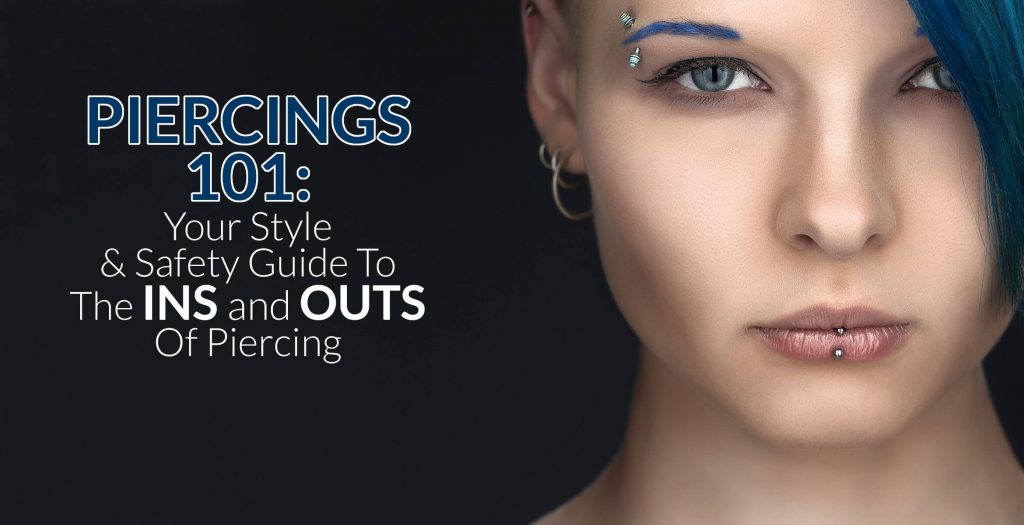
Piercings 101: Your Style and Safety Guide To The Ins and Outs of Piercing
A new piercing 101 is not just a body modification.
It’s also a strong stylistic expression that allows you to adorn your body with jewelry that perfectly fits your look and attitude. On top of that, piercings can demonstrate your position in a culture or subculture, while you take part in a practice with a history as old as civilization itself.
Piercing is an art that has a long history ranging from tribal piercings to beauty iconography.
While piercing 101 comes with its own host of cultural connotations and understandings, there are many benefits to choosing piercing as a way to self-express and modify the body vision.
For one, piercing 101 is considered to be less permanent than tattooing.
This is because most piercings can heal over completely, even when it has been a long time since the original recuperation process. Additionally, someone with a healed piercing can change out their jewelry to take on new styles and statements.
The actual piercing process is a quick, needle-driven technique, with a long yet crucial period of piercing aftercare.
Nonetheless, different piercing professionals have different styles, and it’s still a good idea to look at a studio or professional’s portfolio to gain inspiration and also make sure that you’re in the best place to get what you want. When checking out a portfolio, it’s important to note how the placement of the piercings look.
How to Choose a Location for Your Piercing

Piercings are all about the location on the body.
Many people choose them to accent already positive features that they like about their appearance, such as a dimple. Others choose them to add interest to an area of the body which they think could use some ornamentation.
It’s also important to consider what kind of jewelry you will prefer to wear.
The jewelry that you pick must be compatible with the piercing in both size and shape. Nonetheless, many jewelry types use customizable attachments for their traditional titanium bases.
Jewelry usually has two sizes: gauge and diameter. Gauge refers to the circumference of the part that is inserted through the piercing. The Diameter refers to the distance of two points directly across that circumference. When perusing potential jewelry for your piercing it’s important to keep in mind the shapes and gauge that your piercing will traditionally take.
It’s very important to be realistic about your anatomy when picking a piercing location.
Not every piercing is suitable for every set of features, and some people will not have the available skin to pierce some areas that others have. Piercing an area when there’s not enough space could result in rejection or in some cases nerve damage. It’s important to keep an open mind and listen to the advice of your piercing professional when it comes to placement and location. They will be able to help you choose locations that both suit your anatomy and allow you to enjoy your piercing.
Different Types of Piercings (Health Considerations, Healing Time and Aftercare)
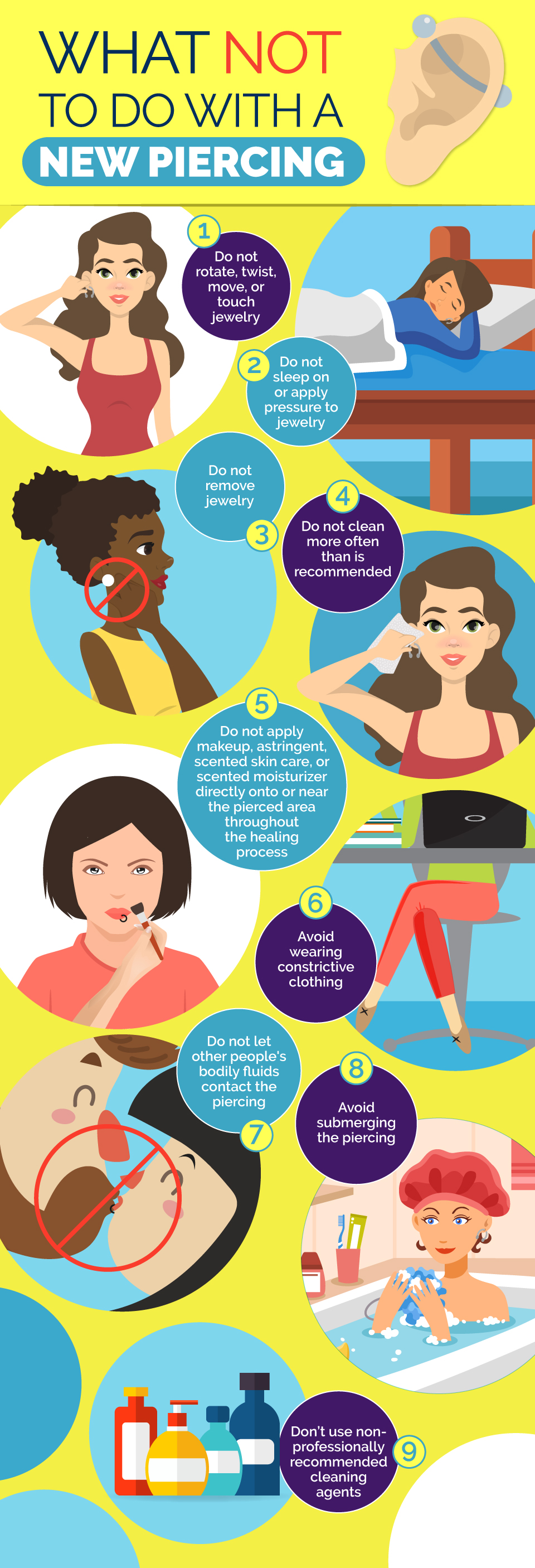
Ear Piercings
When it comes to ears, there are many options and a long tradition of piercing to take inspiration from.
While you should certainly do your research ahead of time and think about what ear designs you might want, keep in mind that everyone has different ears. This means that the spacing of certain parts of your ears may not be suitable to the kind of piercings that you would want. A good piercing artist will help you identify the best parts of your ears to pierce while keeping you open to new or different options.
These designs are sometimes referred to as the curated ear, or a plan of multiple ear piercings that work together with jewelry that is carefully selected for artistic beauty or as an artistic statement.
Although these piercings are designed to work together, they are normally undergone over a long period of time, since it’s generally not recommended to do more than three or four new piercings over the whole body at once.
Ear Cartilage Piercings

- Helix Piercing – This goes through the top cartilage between the rim of your ear and the folded helix.
- Forward Helix Piercing – This is opposite the helix piercing on the upper, inner part of the cartilage. These face forward with the face.
- Conch Piercing – These are inner ear piercings, sometimes worn as rings or bars. The conch can make a beautiful effect but has a high chance of irritation.
- Tragus Piercing – This refers to that little, curved part of the ear closest to the face.
- Daith Piercing – A daith piercing goes through the inner fold of cartilage. These can stand alone if desired and can be accented with a decorative ring.
- Rook Piercing – The rook goes through the little flap of cartilage that’s at the top of the inner ear, just below the helix.
- Industrial Piercings – This refers to two piercings that are connected by one piece of jewelry, most often a bar of steel. This style tends to have a punk connotation, but it can be dressed up with a bar of thin gold or similarly lighter decorative element.
Health Considerations
Cartilage piercings are more prone to infection that lobe piercings. This is because the reduced blood flow means less white blood cells that fight off germs.
All cartilage piercings should begin with surgical-grade titanium to prevent infection.
Those who are considering piercings in spots that are likely to get irritated should avoid piercing with rings until healed. Instead, opt for a nice stud, then you should be able to swap to a ring after about half a year.
Holes in the cartilage, particularly in places that have had to be carved out to accept wider gauges may have lasting consequences, where the hole will not heal back over time. Additionally, improper aftercare may cause permanent deformities from infection, such as cauliflower ear.
Healing Time
The higher the piercing is on the cartilage, the longer the healing time. This is because the further you go up on the ear, the less blood flow there is.
– Daith: About 4 to 8 months.
– Rook: About 6 to 18 months.
– Full Cartilage (such as the upper helix or conch): Anywhere from 6 to 12 months.
Additional Piercing Aftercare
Consistent aftercare is crucial for a cartilage piercing, since there is little blood flow.
Since the ears come into contact with our pillows when we sleep, it is important to avoid sleeping in a way that puts weight on them while they’re healing. It’s also important to wash your pillows and sheets regularly during the healing process and in the long term to prevent infection.
Ear Lobe Piercings
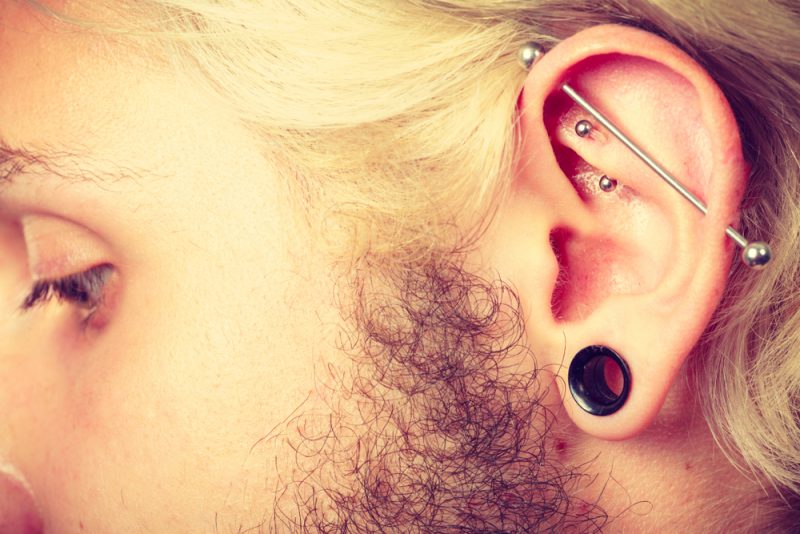
Ear lobe piercings are known for being an entry level staple.
Nonetheless, lobe piercings don’t need to be basic. You can experiment in this case with placement and pierce in a series to make this look more unconventional, such as a high lobe piercing. Additionally, there’s a wide range of jewelry to choose from to vary this look.
- Gauges – Gauging the ear lobes refers to stretching the pierced hole to accept wider gauge jewelry. This can only be done once the earlobe piercing has healed completely. This can create a hole in the lower part of the ear.
- Orbital Lobe Piercing – This is a variation on the traditional lobe piercing that goes straight back through the ear. Orbital lobe piercings go through the lobe from side to side.
– Healing Time: Between 1 and 2 months.
Nose Piercings

- Nostril Piercings – A nostril piercing is anything that goes through the softer cartilage of one side of the nose. This can be a simple stud or a ring.
- Septum Piercing – The septum itself is a thin wall of cartilage that separates the left and right nostrils. Septum piercings do not go through the cartilage but instead go through the soft space of tissue below the septum.
Health Considerations
Since the nose is responsible for filtering the air we breathe, it also collects dirt and bacteria that we don’t breathe in. The bacteria in our noses can make healing a nose piercing difficult and increase the likelihood of infection.
Additionally, some people find it uncomfortable to clean out their noses with water.
Seasonal allergies or individuals who are prone to colds should schedule their new piercing around those times. Those who have severe allergies or frequent sinus infections should think twice before getting a septum piercing altogether. Even after the initial recuperation process, individuals with nose piercings will need to know and learn how to safely blow their nose.
– Nostril Piercing Healing Time: Anywhere from 3-6 months.
– Septum Piercing Healing Time: Around 2 months.
Popular Jewelry
Most nostril piercings begin with tiny jewels. Additionally, both nostril and septum piercings are available in captive bead rings. After the recuperation process, the potential for nasal piercing jewelry opens up to nostril screws and fishtails.
Circular barbells tend to be the most common jewelry for a septum piercing. One thing people love about this jewelry choice is the ability to hide the septum piercing by turning the ends upward into the nose.
Mouth Piercings

Mouth Piercings will usually include one external hole in the skin surface and one oral hole inside the mouth. While the external piercing can be maintained normally, the oral side requires additional care.
- Lip Ring – Lip rings can go anywhere along the top of the upper lip or bottom of the lower lip. This piercing goes through the lip into the mouth.
- Snake Bites – Snake bites refer to two symmetrical lower lip piercings. Both are generally get pierced in the same session to ensure symmetry.
- Medusa or Philtrum Piercing – The philtrum is the area between the upper lip and the nose. Philtrum piercings are generally studs and are high above the lip than a lip ring in the center of the mouth would be.
- Dimple or Cheek Piercings – These go through the inside of the mouth to the cheek. One popular style is the Monroe, or a beauty mark piercing that goes through the upper lip into the mouth.
Health Considerations
Many cheek and face piercings go through the cheeks or lips. These are most commonly done with labret studs. Labrets include a post jewel that is threaded into a flat disc-shaped base.
If not installed snugly enough, the disc anchor could run against the teeth or gums and could erode the enamel or cause gum recession.
One major concern with disc-back jewelry is the possibility that the skin will grow around the back of the disc. In this case, the only way to remove the disc from the cheek or lip is to cut it out. Additionally, it can trap bacteria inside the cheek could lead to infection even after the piercing has healed.
Healing Time
Healing time will typically depend on the thickness of the skin being pierced. Those with thick cheeks or lips will find that the piercing goes through more skin and therefore need more healing time.
– Lips and Mouth Area: Around 2-3 months.
Popular Jewelry
A lot of jewelry is available for the mouth area, including labret studs, fishtail labrets, or ring jewelry such as captive ball rings.
Aftercare
For the oral part of the mouth piercing, follow the oral piercings aftercare below.
Oral Piercings
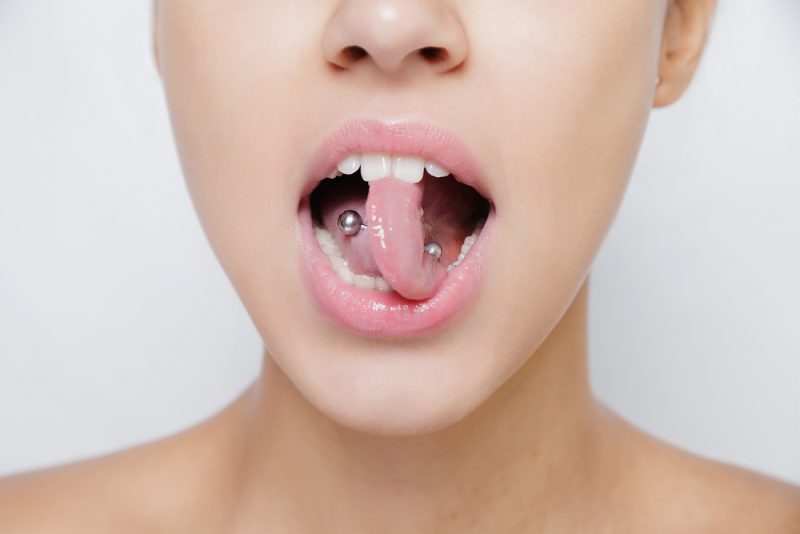
- Tongue Piercings – These can go through the tongue either vertically or horizontally. Since the tongue is full of nerve endings, these piercings are considered to be very painful.
- Frenulum Piercings – The frenulum is the connective webbing around the mouth and tongue. A traditional frenulum piercing goes through the thin strip of connective tissue under the tongue.
- Frowny Piercings – Like frenulum piercings, these go through the thin connective tissue underneath the bottom lip.
- Smiley or Scrumper Piercings – The opposite of a frowny piercing, this goe through the thin connective tissue above the upper lip.
Health Considerations
Oral piercings and tongue piercings in particular have very high pain levels and required education for proper and quick healing.
Since they are inside of the mouth, oral piercings are more easily infected than other piercings. This is because the mouth is always in contact with fluids and bacteria, and you can’t avoid using it. Additionally, the mouth carries its own, often necessary bacteria, used to break down food yet can cause infections or dangerous levels of swelling.
Healing Time
Due to the amount of blood flow in the mouth, oral piercings have a relatively quick healing time.
– Oral Piercing: About three to four weeks for a healthy non-smoker. For a smoker, add a week of healing time, due to the constricted bloodflow.
Popular Jewelry
A tongue piercing will initially use an extra long barbell. The length of the barbell is important because it will need to leave room for the tongue to inevitably swell throughout the recuperation process.
Once the tongue is healed, the extra-long barbell will need to be changed out for a shorter one. This is important because a longer piece of jewelry makes it more likely that the wearer will bite down on it while talking or eating. This could break teeth or damage the tongue.
Additional Piercing Aftercare
- Use an unflavored, alcohol-free mouthwash for an oral rinse. Or, you can mix your own saline solution oral rinse, using 1/4 teaspoon of non-iodized sea salt in 8 oz distilled or pre-boiled warm water. Dispose of unused saline solution each cleaning. If you suffer from a heart condition, opt for the alcohol-free mouthwash over the saline solution.
- Rinse the inside of the mouth for 30 seconds after every meal and once before bed. This will mean rinsing about 4-6 times a day.
- Clean any external parts of an oral piercing as you would for a normal surface piercing.
- Do not play with the jewelry using teeth or your tongue. This can damage the teeth, gums, and the piercing.
- Tighten the barbell ends every day to make sure that they don’t come loose. If they do come apart, you could accidentally swallow the jewelry.
To prevent infection, avoid consuming:
- Beer, wine, alcohol consumption, or sugary drinks
- Spicy foods
- Chewing gum
- Chewing on foreign objects, such as fingernails
You should also avoid smoking, particularly during the first two weeks, while healing an oral piercing.
Dermal and Microdermal Piercings
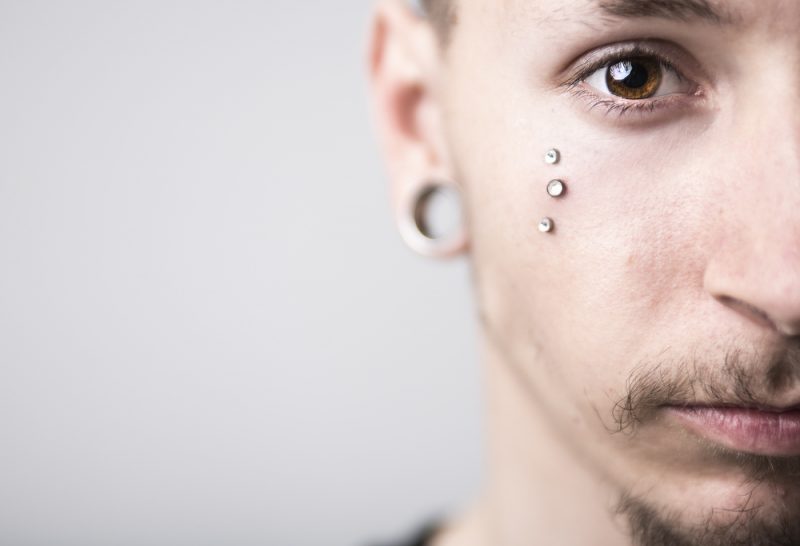
Dermal and Microdermal Piercings – These can be placed in most of the body’s flat surfaces of the body. One end of the jewelry is outside the body, and the other is anchored in the dermal layer of the skin. This allows the piercing to be a small bead on the skin’s surface. The flexibility of microdermal piercings allows them to be subtle ornamentation.
Health Considerations
While microdermal piercings are relatively low risk, since they are embedded in areas with high blood flow, there is the small risk of getting them in areas where the body will reject the piercing. The sternum, for example, is a common area where the body often rejects surface and dermal piercings.
– Microdermal Piercing Healing Time: About 2-3 months.
Nonetheless, the healing time is dependent on the location of the dermal piercing.
Popular Jewelry
Dermal piercings have a base that is permanently embedded in the body to anchor the jewelry. The top is then interchangeable with other internally threaded jewelry. These are extremely flexible, since, once healed, the anchor can be threaded into any metal you desire without that ornamental metal residing within the skin to cause irritation.
Additional After Care
Throughout the healing or recuperation process, it is important to be aware of anything that will pull or catch on the piercing, such as clothing or any other objects. Pulling can unsettle the piercing, causing the body to reject it. It may even cause tearing.
Since dermal piercings are threaded jewelry, it’s important to check the beads daily to make sure they remain tight and stable to the anchor.
Eyebrow Piercings
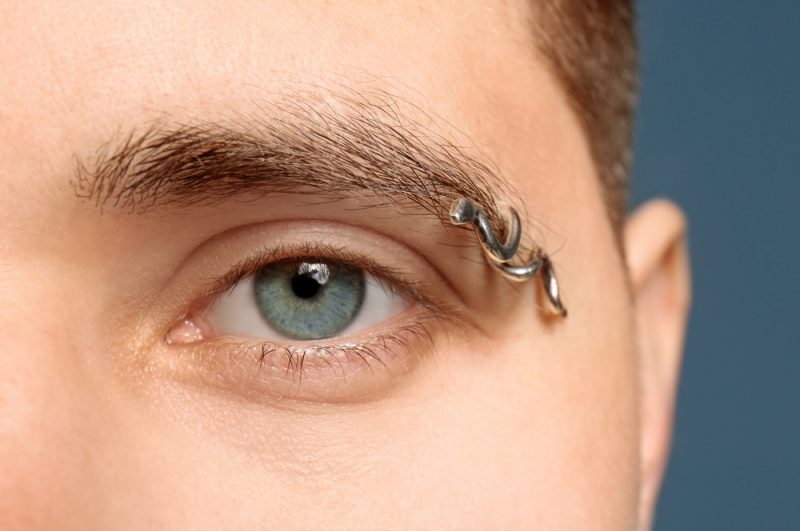
Eyebrow piercings generally describe a piercing along or near the brow. The most common eyebrow piercings include:
- Vertical Piercings – Vertical Piercings tend to be the standard style for eyebrows. These can go anywhere along the brow ridge, though they are most commonly placed at a 35-degree angle from the outside corner of the eye. Most will have two holes, one in and the other out, with a single piece of jewelry looping through. These can also be done in a series to loop a single spiral through four or six holes (2-3 piercings).
- Horizontal Piercings – Horizontal piercings are similar to vertical ones in terms of number and placement. However, in this case, the two holes are side by side.
- Multiple Piercings – Multiple piercings refer to a combination of vertical or horizontal eyebrow piercings. One common style is to overlap a vertical with a horizontal piercing in the shape of a T.
- Bridge (Erl) Piercings – Sometimes described as a nose piercing, these piercings are located between the bridge of the nose and the inner edge of the eyebrow. It’s a horizontal piercing on either side of the nose, right between the eyes.
- Anti-eyebrow – This refers to a piercing opposite the eyebrow, below the eye. These piercings are usually along or just below the ridge of the orbital bone.
Health Considerations
When it comes to eyebrow piercings, there is a possible risk of nerve damage around the eye which can cause migraines. This may happen is the area is get pierced too low in the space between the eye and the brow or too close to the nose. This can be avoided with a placement that gives a wide margin for the eyes and nose and by making sure to find a professional piercer.
– Eyebrow Piercing Healing Time: Anywhere from 2-4 months.
Popular Jewelry
Eyebrow jewelry is generally in the form of fixed ball or captive bead rings or curved barbells. They can also take surface bars, spirals, or circular barbells.
Do not use a straight barbell in an eyebrow piercing.
Additional After Care
Avoid using eyebrow waxes, tinted moisturizers or any scented moisturizers or makeup around the pierced area while the eyebrow is healing.
Nipple Piercings

Contrary to what you might expect, nipple piercings are the same process for both male and female anatomy, with the exception of size. In some cases, nipple piercings increase physical stimulation and arousal. However, for other people, it could decrease the feeling in the nipple, based on personal piercing experience.
Health Considerations
For men with very small nipples, there may not be space to pierce the nipple. If the piercing punctures the breast tissue, it could least to a dangerous infection called mastitis.
Women who have had a pierced nipple can still breastfeed later in life. The piercing should be removed when doing so, but the functionality is not compromised.
– Female Nipple Piercings Healing Time: Around 3 to 6 months.
– Male Nipple Piercings Healing Time: Around 2 to 4 months.
Popular Jewelry
Starter jewelry is normally a straight barbell, curved or circular barbell.
Navel (Belly-Button) Piercings

Navel piercings were very popular in the ‘90s. However, despite their attractive appeal, they can be a difficult piercing to maintain, and they require a long healing window.
Health Considerations
Those who have a physically active lifestyle, such as people who regularly engage in sports, are more likely to build up sweat and bacteria in their navel. This means the navel needs to cleaned out immediately after exercise to prevent infection. Additionally, lifestyles that include a lot of bending, twisting, and movement throughout the navel area, such as dance, gymnastics, or yoga, could make the healing process longer and more difficult.
Those who are overweight or whose skin overlaps their navel when sitting will find it difficult to heal this piercing.
Even navel piercings with proper maintenance can be tricky to heal, since they are prone to migration and rejection.
– Navel Piercing Healing Time: Up to 12 months.
Popular jewelry
Starter jewelry for a navel piercing is usually a curved barbell, also known as a banana bell.
After the piercing is healed there are many possibilities that match the navel’s 14 gauge, including rings and more ornamental jewelry.
Aftercare
Navel piercings generally require a lot of aftercare, since this area inevitably holds a lot of germs.
The recommended piercing aftercare is to spend fifteen minutes twice a day cleaning out the navel and then another ten minutes daily to soak the piercing in saline solution. This is important since the navel is particularly prone to infection.
Genital Piercings
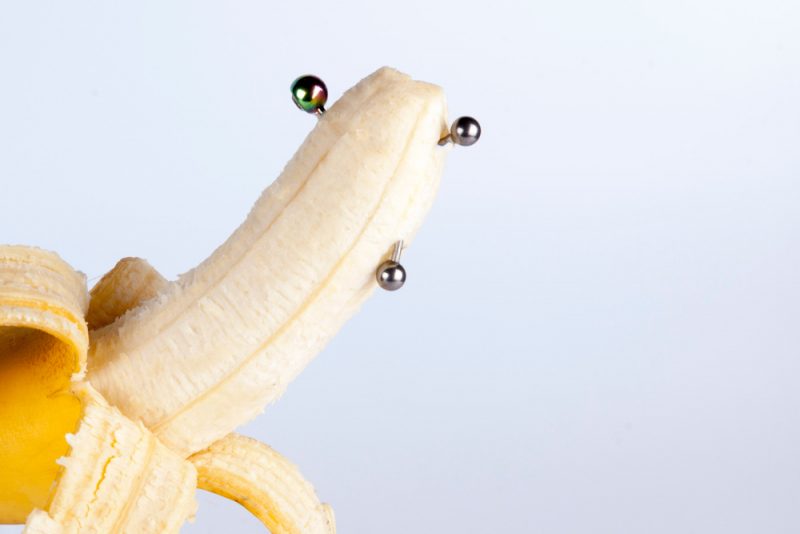
Genital piercings are often chosen for a combination of adornment and enhancing sexual stimulation. Intimate piercings are not always especially painful, particularly when performed by an expert.
Piercings for Female Genitalia:
- Vertical Clitoral Hood Piercing – This is the easiest, lowest pain tolerance, and most stimulating genital piercing for women. It is placed in the same direction of the female genitalia and rests between the legs without strain. This goes through the thin membrane of skin above the clitoris and therefore does not risk damaging nerves. Jewelry then sits under the hood.
- Horizontal Clitoral Hood Piercing – This is also popular as aesthetic ornamentation. However, in most placements, it is not well-suited to offering sexual stimulation.
Piercings for Male Genitalia:
Since the male anatomy has more external genitalia than the female, there are more areas available for piercing. The most popular male genital piercings include,
- Prince Albert – A ring-style piercing that pierces through the glans (head) and urethral opening of the penis.
- Foreskin Piercing – A piercing through the foreskin, most often for aesthetic effects.
- Frenum Piercing – A piercing through the skin at the underside of the shaft behind the glans. Both foreskin and frenum piercings have few complications.
Health Considerations
Due to the sensitivity of parts of the genitalia, piercing certain parts of this anatomy could result in long term nerve damage, and for those with jewelry sensitivity, it can cause additional discomfort. It should only be done by a very experienced and specialized professional piercer.
Healing Time
Depending on the area and the anatomy, genital piercings can vary in terms of intensity and healing time. Male piercings which pass through the glans will take the longest to heal.
– Most Genital Piercings: Around 2 to 4 months.
– Frenum Piercing: 4 to 6 months.
Popular Jewelry
In this case, different jewelry may have different effects on sexual stimulation. Many piercing artists start with jewelry that is simple and easy to heal, but once healed endorse personal experimentation to find one’s personal preference for jewelry.
Additional Aftercare
- Genital piercings require abstinence for one to two weeks. After that point, sex must be hygienic and gentle. If anything makes the piercing sore, it should be stopped. Additionally, it’s necessary to use barrier protection to avoid sharing bodily fluids that may cause the piercing to become infected.
- Never touch the piercing without first cleaning your hands.
- The best place to clean this piercing is in the shower, so that you can allow gentle water to wash over it before cleaning.
- Take only showers, not baths, for the first two weeks.
- Saline solution for washing is preferred to soap which may kill useful and healthy bacteria in the area. Wash twice daily and after intercourse.
- Some discomfort may come from laundry detergents that contain stain-removing or bleaching agents. If you experience discomfort, it can be helpful to switch to a more gentle soap alternative for undergarments.
General Aftercare
Most piercing aftercare uses sterile or prepackaged saline solutions or sprays. You can also look for products at the pharmacy labeled “Saline Wound Wash.” It should only have two contents: sodium chloride (sea salt) and purified water.
You can mix your own saline solution, but you must do it before every use and discard the remains after every use, since this home version can be easily contaminated. To mix your saline solution, dissolve 1/4 tsp of non-iodized sea salt into 8 oz distilled or pre-boiled warm water. Be careful not to add too much salt, as this can irritate the piercing.
Most tattoo shops will also recommend the use of medical-grade antimicrobial soaps that are designed to treat piercings and keep them clean. As an alternative, it’s possible to use a clean, unscented bar of glycerin soap. Just be sure to avoid soaps that contain triclosan.
You should always make your piercing professional’s advice about how to care for your piercing your priority.
How to Clean a Piercing

Throughout the cleaning process, do not push or move the jewelry.
- First, wash your hands.
- Apply a small amount of antimicrobial soap to the skin around both sides of the jewelry, and cleanse for thirty seconds.
- Rinse the area thoroughly, removing all soap bubbles and residue.
- Allow to air dry or pat the area dry with a clean paper towel. Avoid face cloths, hand or cloth towels that may hold bacteria.
How to Do a Saline Soak
- Once per day, soak a clean paper towel or gauze pad in the saline solution. Gently apply this to both sides of the piercing for five to ten minutes.
- Use warm water afterward to rinse away the residue.
Which Piercings Require More Care?

Piercings in parts of the body that naturally hold or cultivate a lot of bacteria or limited blood flow will require the most care.
- This means extra care is needed in warm spots of our body, such as the navel, mouth, and genitals.
- Nasal piercings also require a lot of care due to the amount of bacteria the nose filters every day.
- Cartilage piercings on the ear require care and attention since there is little blood flow to this area to fight off bacterial infections.
- It should be noted that healing times may vary from individual to individual.
What Not to Do With a New Piercing
- Do not rotate, twist, move, or touch jewelry more than you need to. This means avoiding playing with or picking at the area.
- Do not sleep on or apply pressure to jewelry.
- Do not remove jewelry during the healing period.
- Do not clean more often than is recommended, since too much cleaning can cause the skin to become dry and irritated.
- Do not apply makeup, astringent, scented skin care, or scented moisturizer directly onto or near the pierced area throughout the recuperation process.
- Avoid wearing constrictive clothing or put on anything that will snag the piercing.
- Do not let other people’s bodily fluids contact the piercing. This includes kissing, oral sex, and sharing foods or drink.
- Avoid submerging the piercing, since baths, swimming pools, or natural bodies of water can carry a lot of infection-causing bacteria.
- Do not use rubbing alcohol, hydrogen peroxide, or other cleansers or ointments not recommended by your piercing professional.
Risks and Prevention
The main risks of body piercings include infection or the body rejecting the piercing. Sanitary piercing conditions and proper aftercare go a long way toward mitigating risks.
Piercings that are years old can still heal over or close up quickly after removing the jewelry. To protect the longevity of your piercing, it’s important to keep jewelry or a placeholder in it as much as you can. If the jewelry comes out of a new piercing that has not healed, it’s likely that you will have lost the piercing. To try to salvage the piercing you should see a professional piercer as soon as you can.
Even after the recuperation process, it’s important to sterilize new pieces of jewelry before you use them. Whether you’re buying from a store or online, it pays to be careful and this can help save you from contracting infections.
The Best Jewelry Materials

Hypoallergenic jewelry helps the body better accept the piercing. Surgical-grade titanium or gold tend to be hypoallergenic and run the lowest risk of infection when in contact with your body. Additionally, titanium is preferable throughout the healing process, due to its purity, quality, and resilience.
Common metal allergies include silver, nickel, and cobalt. In some cases, silver can cause argyria, which discolors the skin. You should never wear silver in areas where there are mucous membranes, such as the nose, mouth, nipples, and genitals.
The grade of the metal isn’t the only important factor. You should also consider the manufacturing and finish. Many piercing studios have preferred makers of body jewelry. All body jewelry should meet the standards set by the Association of Professional Piercers (check the link for technical information on the best metals for piercing).
Normal Healing Experiences
During the recuperation process, it’s normal to experience a manageable amount of discomfort, or even pain tolerance. You might also see some swelling and redness.
The first week of healing might see some bleeding or scabbing. Additionally, some areas may experience a white or yellow fluid that dries into a crust around the piercing area and onto the jewelry. If, however, you are experiencing thicker or foul-smelling pus or ooze, this could be a sign of an infection.
Metal jewelry cannot get stuck to the skin, so there is no reason to twist it or move it around. Twisting during the healing process only results in reopening and irritating the piercing.
Be aware of mild itching, burning, or throbbing throughout the healing period. At all costs avoid scratching, friction, or making too much contact. Bumping or snagging the piercing may result in swelling or bleeding. This is normal and should be temporary. Follow you normal cleaning procedures until the swelling subsides.
Hypertrophic Scarring or Bumps on Your Piercing
Bumps can form on both sides of a piercing, particularly when the piercing is more difficult to heal, such as cartilage, or areas that experience a lot of motion and contact. These bumps are from hypertrophic scarring. They appear because your body vision is trying to heal but continues to experience disruptions, such as pressure, movement from the jewelry, or picking at scabbing.
Hypertrophic scarring can be treated by regular cleaning and a chamomile compress. To do this, soak a small clean cloth towels in steeped tea of warm, pure chamomile. Apply this directly to the bump and gently press for a few minutes until the cloth towels cools. Repeat until the chamomile is no longer warm. Do this twice a day and the bump should begin to recede after a week.
Symptoms You Should Look Out For
- The area around the piercing is abnormally red, extremely swollen, overwhelmingly painful, or the skin around it feels hot to the touch.
- The piercing is secreting a greenish or bad-smelling pus. This will be noticeably different from the normal white or yellow puss that crusts around the jewelry.
- There is tenderness in the surrounding area.
- You experience a fever or run a temperature within a few days of getting the piercing.
If you think that your piercing is infected, don’t remove the jewelry. This could trap the infection under the skin and cause an abscess. Instead, visit a doctor or clinic as soon as possible. You will likely require antibiotics to treat the infection.
Safety

For your safety, it’s best to avoid piercing guns. This includes a squeeze piercer. Instead, opt for piercing professionals who pierce by hand using a clean, sterile body-piercing single use needle. This is because it’s difficult to clean and fully sterilize a piercing gun, increasing the risk of contamination and infection. Additionally, piercing guns increase the risk of trauma to the skin from the lack of accuracy, scarring, and displaced scar tissue. While hand piercing minimizes scarring by using sharp, hollow single use needles, the piercing gun will use a blunt stud to push the displaced skin to the back of the hole and allow it to heal and scar there.
Always find a reputable piercer who uses hygienic tools and will make you feel comfortable. Word of mouth and candid reviews will tell you a lot about a piercing studio. Additionally, if you see a piercing that you really admire, it generally doesn’t hurt to ask the wearer where they got it done. Those who wear their piercings proudly are often happy to give a referral for skilled professionals.
Only go to a studio that has an autoclave. Autoclaves sterilize the reusable equipment. All of your hygienic tools need to be sterilized and opened from plastic packages right in front of you by gloved hands.
Additionally, your piercer should wear gloves at all times. When they take their gloves off, they should replace these with new gloves before touching skin.
If the piercer uses a pen to mark the placement of the piercing on your skin, make sure that it is brand new, and they should throw the pen away after using it.
It’s a good idea to visit the studio prior to getting your piercing. This might mean making an appointment in person and meeting your piercer so you need to know the place is clean and that you feel comfortable there. You might also want to visit multiple studios to get a feel for what you like versus what you don’t.
Conclusion
Piercing is a body modification that allows an individual to customize their appearance with beautiful and distinctive jewelry. There are a variety of locations for a piercing that suits your individual taste and lifestyle. However, piercings require diligent maintenance, particularly during the initial healing period. This will make it so that the piercing heals without long term consequences and scarring from infection or rejection.


